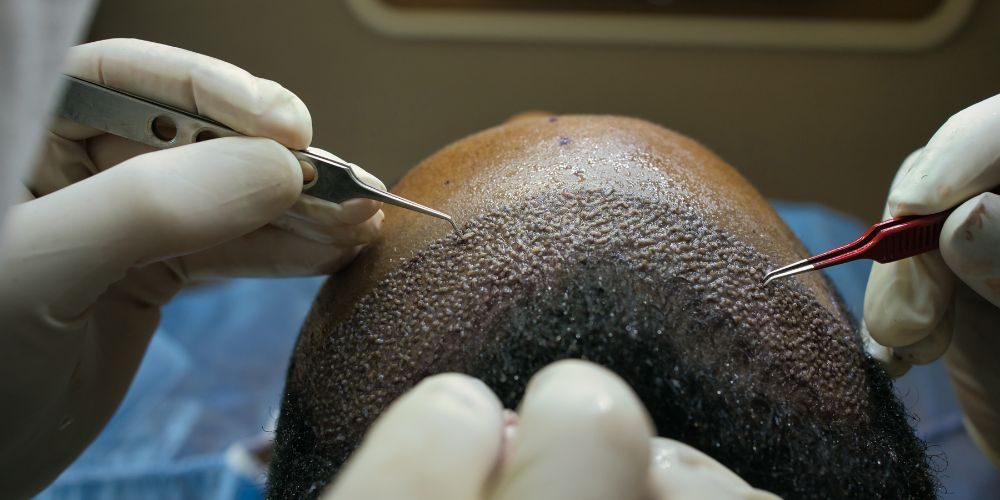Hair loss affects millions worldwide, impacting confidence and self-esteem. A hair transplant offers a promising solution, with modern techniques that ensure natural-looking and long-lasting results. With advancements in medical technology, hair transplantation has become more effective, minimally invasive, and safer than ever, helping people regain both hair and confidence.
What is a Hair Transplant? Understanding the Basics
A hair transplant involves relocating hair follicles from a donor area, typically the back or sides of the scalp, to areas experiencing hair loss. This procedure, known as follicular unit transplantation (FUT) or follicular unit extraction (FUE), is highly individualized, designed to match each patient’s unique hair growth patterns for seamless, natural results.
Types of Hair Transplant Procedures
- Follicular Unit Transplantation (FUT)
In FUT, a strip of scalp is removed from the donor area, and individual follicular units are extracted and transplanted to balding areas. This technique can move a large number of follicles in a single session, ideal for those requiring extensive coverage. - Follicular Unit Extraction (FUE)
FUE involves removing individual follicles directly from the scalp without the need for a linear incision. This minimally invasive method results in less scarring and quicker recovery, making it a popular choice for those seeking less visible scarring. - Direct Hair Implantation (DHI)
DHI is an advanced version of FUE where follicles are implanted immediately after extraction, reducing the time the grafts remain outside the body. This method is renowned for its precision and is commonly used for denser and more natural results.
Benefits of Hair Transplantation: Why Choose This Procedure?
1. Permanent Results
Unlike temporary solutions like wigs and medications, hair transplants provide a permanent solution to hair loss. Transplanted follicles continue to grow naturally for a lifetime, requiring minimal maintenance.
2. Natural Appearance
Hair transplantation techniques focus on creating a natural hairline and density that blend seamlessly with existing hair. With skilled surgical planning, the results mimic natural growth patterns.
3. Low Maintenance
Once the transplanted hair follicles are established, they require the same maintenance as natural hair, allowing individuals to style and care for their hair without special treatments or products.
Preparing for a Hair Transplant: Key Considerations
1. Choosing a Qualified Surgeon
Selecting an experienced and reputable hair transplant surgeon is crucial for achieving the best results. Look for certified professionals with extensive experience and positive patient reviews.
2. Assessing Candidacy for the Procedure
Not everyone is a candidate for a hair transplant. A qualified surgeon will assess factors like age, hair loss pattern, and donor area density to determine if the procedure is suitable.
3. Pre-Surgery Guidelines
Patients are typically advised to avoid smoking, alcohol, and certain medications before the surgery, as these can interfere with healing and graft survival. Following pre-surgery instructions is essential for a successful procedure.
The Hair Transplant Procedure: Step-by-Step
1. Consultation and Hairline Design
During the initial consultation, the surgeon will design a hairline that complements the patient’s facial structure. The goal is to ensure natural, aesthetically pleasing results.
2. Anesthesia Application
Local anesthesia is administered to ensure a comfortable and pain-free experience. In some cases, a mild sedative may be offered to reduce anxiety.
3. Extraction of Hair Follicles
In an FUE procedure, individual follicles are extracted from the donor area using specialized tools. For FUT, a strip of scalp is removed, and follicles are carefully dissected.
4. Graft Preparation and Preservation
Extracted grafts are prepared for transplantation and kept in a carefully controlled environment to ensure their viability.
5. Implanting the Grafts
Using specialized tools, the surgeon meticulously implants each graft into the recipient area, following natural growth patterns to achieve uniform and realistic results.
6. Post-Procedure Care
After the surgery, patients are provided with detailed aftercare instructions, which are crucial for ensuring graft survival and optimal healing.
Post-Surgery Recovery and Care
1. Immediate Post-Op Instructions
Patients are typically advised to avoid washing their hair for the first 48 hours and to follow a gentle cleaning routine thereafter. Avoiding sun exposure and strenuous activity helps in the healing process.
2. Managing Swelling and Discomfort
Mild swelling and discomfort are common in the first few days following the procedure. Cold compresses and prescribed medications can alleviate these symptoms effectively.
3. Hair Growth Timeline
New hair growth usually begins within 3-4 months post-surgery, with full results visible between 9 to 12 months. Transplanted hair continues to grow naturally, just like the rest of the hair on the scalp.
Potential Risks and Complications
While hair transplants are generally safe, understanding potential risks helps in making an informed decision.
- Infection – Rare but can be managed with antibiotics.
- Scarring – FUT procedures may leave linear scars, while FUE results in minimal scarring.
- Shock Loss – Temporary shedding of transplanted and surrounding hair, which typically regrows over time.
- Unnatural Results – When performed by an unskilled surgeon, the results may not appear natural, which is why choosing a reputable surgeon is essential.
Expected Costs of Hair Transplant Procedures
The cost of hair transplant procedures varies depending on factors like the extent of hair loss, the technique used, and the clinic’s location. In general:
- FUE is typically more expensive than FUT due to its labor-intensive nature.
- Clinics in major metropolitan areas tend to have higher prices than those in smaller cities.
On average, patients can expect to pay between $4,000 and $15,000 for a hair transplant, though pricing can vary significantly.
FAQs about Hair Transplantation
1. How long do hair transplant results last?
Hair transplant results are generally permanent as the transplanted hair follicles are resistant to the hormone responsible for hair loss.
2. Are there age restrictions for hair transplant surgery?
While there’s no strict age limit, individuals under 25 are generally advised to wait until their hair loss pattern stabilizes.
3. Can women undergo hair transplant surgery?
Yes, women can benefit from hair transplants, especially in cases of thinning hair or specific bald spots. However, women with diffuse hair loss may require different treatments.
4. Will the transplanted hair look natural?
With modern techniques like FUE and DHI, the transplanted hair looks natural and blends seamlessly with existing hair.
5. What are some alternatives to hair transplantation?
For individuals not ready for surgery, alternatives like PRP therapy, low-level laser therapy, and medications like Minoxidil can help in managing hair loss.
Conclusion: Achieving Lasting Confidence through Hair Transplantation
Hair transplantation is a transformative solution that offers both men and women a chance to restore their hair and confidence. With skilled surgeons, advanced techniques, and comprehensive post-operative care, patients can achieve natural, lasting results. This minimally invasive, highly effective solution is reshaping the way we approach hair loss, providing hope and rejuvenation to millions.
SHAYONAM 3IN1 Portable Car Vacuum Cleaner with Blower | USB Rechargeable Wireless Handheld Car Vacuum Cleaner Traveling, Camping Reusable,Portable,Rechargeable (Vacuum with Blower)(Multy)/*-
₹699.00 (as of 14 November, 2024 18:26 GMT +05:30 - More infoProduct prices and availability are accurate as of the date/time indicated and are subject to change. Any price and availability information displayed on [relevant Amazon Site(s), as applicable] at the time of purchase will apply to the purchase of this product.)SWAPKART Double Layer Soap Dispenser for Bathroom Accessories Dishwasher Liquid Holder Liquid Dispenser Pump with Sponge Holder Kitchen Sink Accessories Items(Multi Colour)
₹149.00 (as of 14 November, 2024 18:26 GMT +05:30 - More infoProduct prices and availability are accurate as of the date/time indicated and are subject to change. Any price and availability information displayed on [relevant Amazon Site(s), as applicable] at the time of purchase will apply to the purchase of this product.)Amazon Brand - Presto! Garbage Bags Small 180 Count|17 x 19 Inches Black , For Dry & Wet waste|30 bags/roll (Pack of 6)
₹289.00 (as of 14 November, 2024 18:27 GMT +05:30 - More infoProduct prices and availability are accurate as of the date/time indicated and are subject to change. Any price and availability information displayed on [relevant Amazon Site(s), as applicable] at the time of purchase will apply to the purchase of this product.)Milton Flip Lid 500 Thermosteel Vacuum Insulated Double Walled Flask with Drinking Cup lid & Jacket,1000 ml Water Bottle,24 Hours Hot & Cold,Easy to Carry,Easy Grip,Rust Proof,Tea,Travel Bottle,Silver
₹647.00 (as of 14 November, 2024 18:27 GMT +05:30 - More infoProduct prices and availability are accurate as of the date/time indicated and are subject to change. Any price and availability information displayed on [relevant Amazon Site(s), as applicable] at the time of purchase will apply to the purchase of this product.)Pigeon Polypropylene Mini Handy and Compact Chopper with 3 Blades for Effortlessly Chopping Vegetables and Fruits for Your Kitchen (12420, Green, 400 ml)
₹168.00 (as of 14 November, 2024 18:27 GMT +05:30 - More infoProduct prices and availability are accurate as of the date/time indicated and are subject to change. Any price and availability information displayed on [relevant Amazon Site(s), as applicable] at the time of purchase will apply to the purchase of this product.)Discover more from The General Post
Subscribe to get the latest posts sent to your email.





